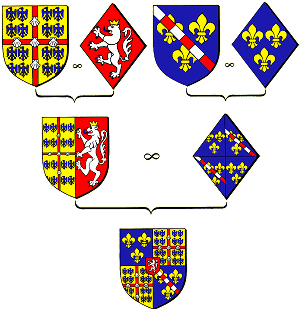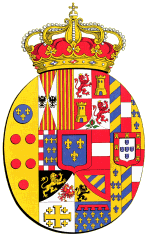Coat of Arms - Marshaling
Marshaling is the act of combining armorial bearings to represent more than one family, country, city, etc. There are rules governing the placement of the armorial bearings according to their status. A man who married an heiress could choose to divide the shield of his own coat of arms to include a charge from his wife's coat of arms. The amount of space allotted to the wife's armorial bearings ranged from one half of the shield to one quarter or less and was generally determined according to the status of the wife's family. Succeeding generations could continue to divide, or marshal, a coat of arms shield to reflect the unions that had taken place.
The four coats of arms below represent the bearings of four individuals. When each couple married, they chose to marshal their coat of arms, as shown by the second grouping. These coats of arms would have been borne by their children. If a child from each of these unions married, the result of marshaling would be the bottom coat of arms.

| One of the most complex marshaling of a coat of arms is that of the kingdom of the Two Sicilies. It is a combination of the five arms of Spain and the six arms representing Austria-Burgundy, to which the arms of the house of Bourbon-Anjou were added in 1701. |
 |
The Royal Coats of Arms of the United Kingdom have evolved over many years and reflect the history of the Monarchy and of the country through marshaling.
See the Royal Coats of Arms page for more information.
